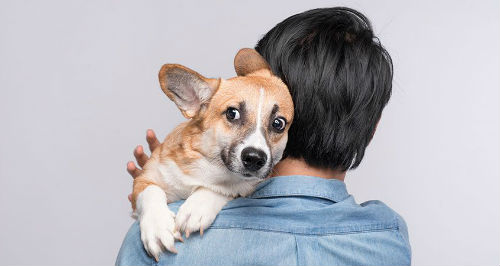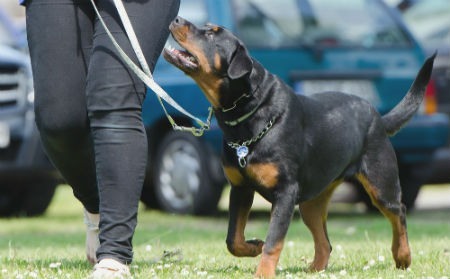Sociability is one of the characteristic traits of the canine species. In general, dogs are animated when sharing with their human family, with their peers and with other species. Even so, it is normal to come across domestic pets that express fear and insecurity in front of other dogs . Each dog has a different personality and behavior, appropriate to its habits, life history and even breed. Therefore, just as there are extroverted dogs, there are others that are more shy and withdrawn.
How to interpret what my dog expresses?
Body language is the main tool you have when identifying what your pet is feeling . The postures and movements, especially of its tail and ears, in addition to barking, growling and vocalizations, are the way it expresses its emotions. By being aware of this set, it will be easier to act appropriately to help you overcome fears .

Identifying body language
-
The look : When feeling vulnerable, the dog's gaze appears from below, taking care not to lose sight of the figure or situation that generates distress and at the same time trying to look threatening.
-
The ears : They are usually drawn back as a sign of alert and attached to the head.
-
The body : The contraction of the muscles and the shrinking backwards is intended to show helplessness, as well as remaining paralyzed or using the human as a wall of protection.
-
The tail : The shrunken rear area and the tail tucked between the legs shows nervousness and is a protective maneuver for its body.

If your pet adopts some of these postures and attitudes towards other dogs, keep in mind that your goal should not be to eliminate fear, understanding that it is a natural alert reaction to any situation that represents danger to it. Your job will be to progressively make him understand that he can relate to his environment without it being a problem and that you will be there to guarantee his well-being. Otherwise, the fear can become a phobia capable of causing greater harm .
Causes of fear in dogs
To determine which situations involving other dogs make your pet uneasy, pay attention and study their behavior. There are various factors that influence the way they establish bonds with other canines.
-
Traumatic experiences : A dog's fears, even towards others of its species, can be the product of strong or traumatic emotions from the past, especially from its first years of life.
If your dog is adopted, ask his previous family for details about his puppy life. Any data, no matter how minimal it may seem, is important. Even a rough game you had with a larger, more energetic partner could have caused the damage.
-
Poor socialization : The lack of contact with the outside world during the puppy stage, essentially between 2 and 4 months of age, harms the dog's adult life. If it was not related to other dogs, with children and adults; or with sounds, smells and public spaces, now it will be more complex.
Genetic predisposition has an implicit impact; some dog breeds are “less social” or more solitary. Having been separated from his mother and siblings early could also be detrimental to the canine.
-
Reinforced fear : Your behavior can also reinforce their fears. Although it may seem cruel, avoid petting it, hugging it, or speaking in too soft a tone when it appears distressed in front of other four-legged dogs. By doing so you would be approving his behavior and telling him that he does have something to fear. Just because you don't consent to it doesn't mean you're indifferent to what it's expressing.
What can I do to help you?
Helping your furry friend overcome his fears of other dogs requires an action plan with clear strategies and a period of adaptation. The effectiveness of the two elements will depend almost 90% on your dedication. The key words are: patience, love and progressiveness. When we talk about strategies we are referring to the techniques used for dog training. You don't have to be an expert to apply them, but you do have to be consistent and follow them almost to the letter.
-
Progressive desensitization : Despite sounding complicated, these are simple tasks such as walking with your pet in places that they generally frequent and where they will face their fears.
The objective is for him to share the same space as other dogs, maintaining a safe distance that will gradually be reduced. It is not about forcing it to socialize, but about being able to tolerate the presence of another animal. It won't be a matter of an afternoon in the park, it will be days of training. Another good exercise to
get him used to the presence of other dogs is to keep him in the same environment, separated from the others by a glass door or window through which they can see and smell each other, but avoiding friction that could make him uncomfortable.

If you have a pack, your support stick will be the canine with leader attitudes (the one who is insecure will then be his follower), but show the excitable and dominant dog that you are still the boss, in this way you will be claiming the territory of the insecure one. and you will do it strong. Don't push the shy one, wait for him to just come into contact. The same thing that applies in situations with unknown dogs with your pet.
-
Positive reinforcement : Once you consider that your pet is already overcoming its greatest fear, being in the same environment with other animals, then apply positive reinforcement. It is about rewarding him for what is considered good behavior, the incentive can be anything from a cookie to a toy.
Should consider…
It is important
to respect your pet's learning process and adapt the techniques according to the responses it gives. Affection and patience will be the basis of a new and happy experience for your pet with others of its species. That said, if you don't feel confident that you can perform these techniques without putting your dog at risk, then it is best to turn to a professional.
Find more information about pets on our blog:
















